31+ Latest Remote Work Statistics For 2024
Are you curious about the state of remote work? We’ve got you covered.
Even before the Covid-19 pandemic hit, many workers—and even businesses—have come to see the benefits of working remotely.
But will the dramatic shift to remote work make sense still make sense in the future? And what do employees think about remote work?
In this post, we’re sharing the most recent remote work statistics available so you can get a clearer understanding of this increasingly popular way of working.
Editor’s picks
- Remote workers are more satisfied with their jobs. (CNBC)
- By 2028, 73% of all departments will have remote workers. (Upwork)
- Remote workers earned salaries higher than $100,000 per year. (Owl Labs)
Remote work adoption statistics
People are more accepting of remote working conditions. The key remote work statistics show that employees have come to like working from home, especially during the peak of the pandemic.
And by all indications, remote work arrangements will remain a thing — at least until everything settles back down. However, companies are already looking into updating their policies to make room for hybrid setups that’ll allow people to work from home some of the time.
Below are some interesting statistics about remote work adoption.
People are more comfortable working remotely.
People are responding positively to employers looking for employees to work remotely since the pandemic started. In a survey of 4,000 people who are working remotely after the Covid-19 hit, 51% reported that they find their new arrangement more productive.
An overwhelming 95% even went as far as to say that working from home made them as productive or better as they did when working in the office.
The reasons why they felt more productive include fewer interruptions (68%), more focused time (63%), a quieter work environment (68%), a more comfortable workspace (66%), and avoiding office politics (55%).
Source: Flexjobs
Remote workers are more satisfied with their jobs.
CNBC reports that remote workers are more satisfied with their jobs compared to in-office employees. 57% of the remote workforce said they are very satisfied with their job while only 50% of office workers said the same.
There are other differences — all in favor of working remotely. 81% said they felt well-paid versus 75% of those who still report to work. 66% said they have good or excellent career advancement opportunities versus 58%. And 54% said their contributions at work are more valued by colleagues versus 48%.
Source: CNBC
Remote workers are able to maintain or exceed productivity.
In a survey by the Boston Consulting Group, 75% of remote workers said that they were able to maintain or improve their productivity during the first few months of the pandemic.
51% said that they had no problem maintaining or improving productivity on collaborative tasks.
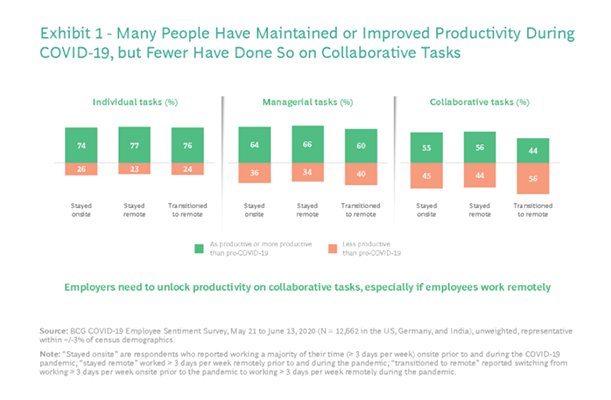
One of the reasons cited for this is social connectivity. Employees who said that they are satisfied with their social connectivity are two or three times more likely to have maintained or improved their productivity on collaborative tasks.
Source: Boston Consulting Group
By 2028, 73% of all departments will have remote workers.
A study shows that by 2028, 73% of all departments will have remote workers. In addition, 69% of younger general managers have team members who are allowed to work remotely.
Of the offices that allow remote work, 74% said that they have team members who spend most of their time working away from their place of business. Only 58% of baby boomers have employees who work a significant portion of their time remotely.
Source: Upwork
Remote employees end up working more.
On average, work-from-home employees end up working 1.4 more days every month than their in-office counterparts. That translates to 16.8 more days every year.
And while office workers reportedly spend an average of 37 minutes each day not doing anything (outside of breaks), remote employees only lose 27 minutes each day to distractions.
Yes, remote work employees tend to take more breaks. However, studies show that these breaks lead to higher rates of productivity.
Source: Airtasker
There were plenty of remote workers even before the pandemic.
A 2019 survey showed that out of 1,202 respondents, 745 or 62% work remotely at any frequency while 457 (38%) worked on-site. The respondents were full-time workers in the US between the ages of 22 and 65.
Of the 745 respondents who said they work remotely at different frequencies, 54% said they work from home at least once a month. 48% said they work from home at least once a week. 30% said that they work remotely on a full-time basis.
Source: Owl Labs
Majority of employees would like to work remotely some of the time.
A whopping 99% of respondents in a Buffer survey said that they would like to work remotely at least some of the time for the rest of their careers.
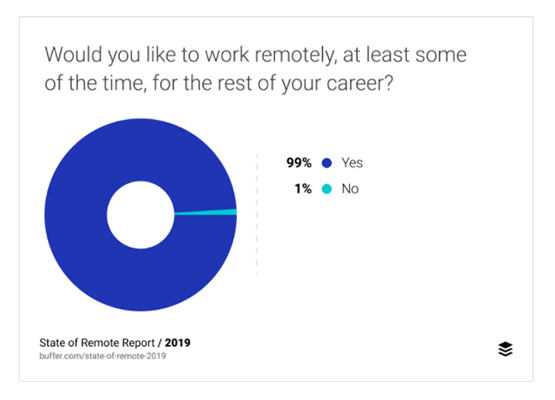
This proves that the work-from-home arrangement is not a trend. It’s here to stay.
And of those that are already working from home, 95% of them said that they would recommend remote work to other people including friends and family members.
Source: Buffer
Remote work affected Canadians’ willingness to commute.
In a study, a third of Canadians expressed a desire to commute less than 15 minutes after a year of working from home due to the pandemic.
22% of Canadians want to work from home entirely while 40% want a hybrid model that would allow them to blend in-person and remote working.
Only 12% of the 1,500 surveyed Canadian respondents are okay with traveling more than 15 minutes to get to work daily.
Source: The Globe and Mail
Just 1 in 5 companies plan on working fully in-person in fall 2021.
Only 19% of companies are planning on resuming in-person operations come fall of 2021 because of the Covid-19 pandemic.
About a third of the executives surveyed for the report said that they’re planning on pursuing a hybrid model that involves in-person, fully remote, or a combination of the two.
Source: Fortune
Hybrid work setups can ease the transition back to in-person working.
Hybrid workers feel stronger connections with colleagues more than on-site workers (79% versus 70%). It’s also worth pointing out that the connections are strongest among parents of children under 18-year-olds who work in a hybrid arrangement (83%).
You might also find it interesting that employees that work using a hybrid work arrangement have a more positive outlook on their managers compared to on-site and remote workers.
Manager attention and perception of career opportunities are reported to be the strongest with 72% saying they receive constructive feedback. On-site workers are only at 57% while remote workers are at 64%.
Source: ADP Research Institute (via PR Newswire)
Workers are quitting their jobs for more flexible work arrangements.
Workers are now quitting their jobs in search of better options partly due to how technology has enabled everyone to work from wherever they choose. Some have only come to realize because of the pandemic lockdowns that cloud-based solutions can give them an alternative to their current work setups.
That’s the reason why some companies are now debating on how they’ll transition after the pandemic is over and done with. Some are looking into hybrid models while others are exploring the 100% remote scheme.
Source: Entrepreneur
Remote work business statistics
Before the pandemic hit, businesses did not know that the work-from-home arrangements they’ve set up as a temporary fix will become the new normal for most of their employees. They’ve had to learn how to adapt to maintain some sense of order.
As you’ll see in these remote work business statistics, a lot of companies are now considering implementing work schedules that’ll allow their employees to telecommute.
82% of company leaders plan to allow employees to work from home.
A survey made to 127 company leaders revealed that 82% of them plan on allowing employees to work from home as life returns to normal after the pandemic. 47% even said that they intend to allow employees to work remotely on a full-time basis going forward.
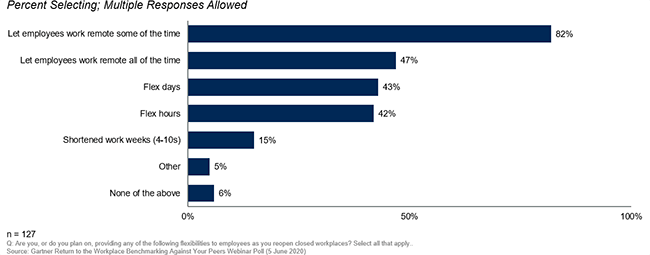
Companies view the pandemic as an experiment in widespread remote working. Allowing work-from-home arrangements is their way of meeting employee expectations while building a more resilient business operation.
Source: Gartner
CEOs plan on increasing their share of remote workers.
A survey of 699 CEOs on emerging business models shows that their priority lies in digitizing their core business operations and processes as well as adding digital products and services.
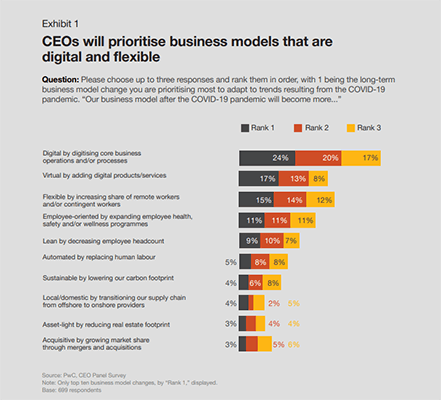
However, they’ve also expressed interest in increasing their share of remote workers and/or contingent workers.
Source: PWC
Salesforce introduced a hybrid work schedule for its employees.
In August 2020, Salesforce, a cloud-based software company, announced that its employees will start working from home until July 2021.
And to ensure that their employees will have what they need to do their jobs, the company gave them $250 on top of $250 given earlier in the year. The money could be used to purchase office equipment and tools.
With this arrangement, Salesforce now only expects more than 65% of its workforce to only come in one to three days a week. The company even went as far as to say that the traditional 9-to-5 workday is dead.
Source: Forbes
93% of organizations have a policy for work-from-home arrangements.
All organizations should have a policy that dictates how employees can mitigate the risks of working from home. But as it turns out, 93% of businesses already have a formalized policy in place.
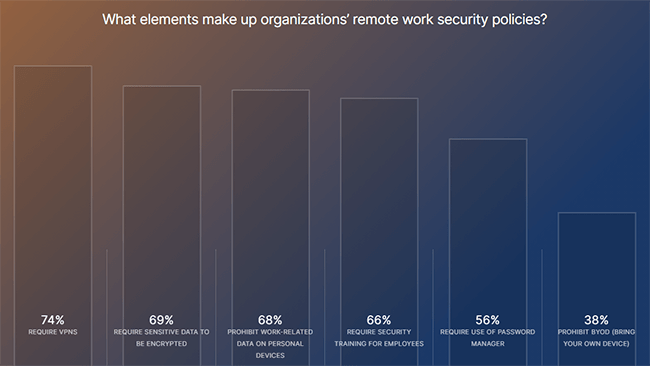
To reinforce the importance of cybersecurity for work-at-home employees, organizations have security education sessions. 90% of businesses require remote workers to attend cybersecurity training.
Source: Open VPN
People in digital industries think remote work and effective operations go together.
75% of people that work in digital fields like software, finance, and media believe that remote work and effective operations go hand-in-hand.
Reception isn’t as high for those working in other fields though. Only 48% of those in the healthcare space are optimistic that a remote setup could work. The manufacturing sector is only at 41%.
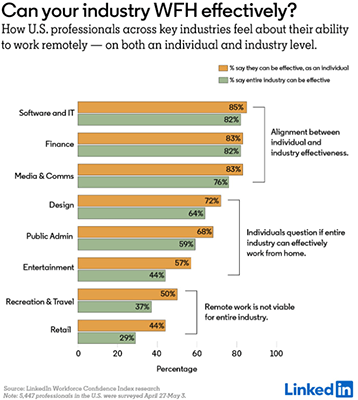
Curiously, the ones in the retail space are the least optimistic with only 29% of them thinking a remote office setup can work.
Source: LinkedIn Pulse
Remote work is hurting other industries.
When the pandemic hit, 42% of America’s workforce started working from home — almost double the previous year. This arrangement affected other sectors even as the workforce is starting to recover and go back to offices.
Because a lot of workers are staying at home, nobody is spending cash on services like restaurants, coffee shops, and public transportation. In New York, subway ridership still hasn’t hit half of what it had pre-pandemic.
Other businesses that workers frequent before getting to work are also struggling.
Source: CNN
Those in the computer/mathematical occupations will still work remotely.
In a July 2021 survey, the Bureau of Labor Statistics reported that 49% of those in the computer and mathematical occupations will still work remotely because of the pandemic.
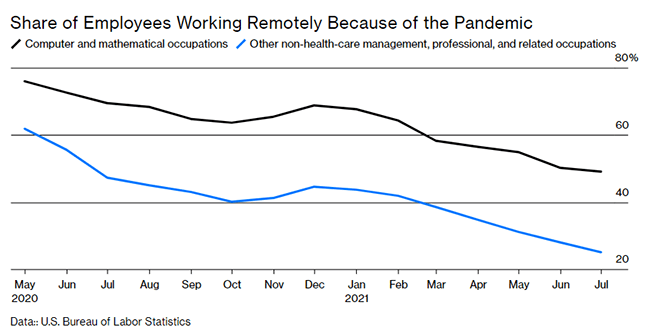
Computer and mathematical occupations include jobs like software developers and testers, user support specialists, and system analysts. Finding labor for these jobs is not that easy. That’s why workers in these fields have some leverage regarding work-from-home decisions.
Also, the talent pool for these jobs is often global, which is why employers have reasons to look far afield.
Source: Bloomberg
94% of employers believe remote work has not hindered productivity
If the increase in the adoption of remote work is to be maintained, it has to be productive. This is why the productivity of remote work is a serious consideration for businesses.
According to one survey, 94% of employers believe that remote work hasn’t negatively impacted productivity. And 27% felt that productivity has improved.
Surprisingly, only 6% felt that productivity was worse than before their team started working remotely.
Source: Mercer
Remote work satisfaction statistics
While some still have reservations about working remotely, a huge part of the remote workforce has come to enjoy all the benefits of this arrangement. They saw a great improvement in their quality of life. In particular, workers are now enjoying more time with their family and friends.
As a result, remote workers are now happier and are being more productive than they were back when they had to report to the office in person.
Here are a few remote work satisfaction statistics that are worth checking out.
Remote work cut down on long commutes to the office.
Out of 4,000 respondents, 36% said that their work commutes took two or more hours per day. It’s no surprise then that 79% of respondents cited the lack of commuting as the reason why their lives are better today now that they’re working remotely.
72% also added that they enjoy no longer having to pay for commuting costs.
This also led to people having a better work-life balance. 46% said they now have more time to spend with their family/children. 42% now have more time to spend with their partner. And 37% now have the ability to take care of their pets.
Source: Flexjobs
Remote workers score higher on the Workforce Happiness Index.
In a joint survey by CNBC and SurveyMonkey, they found that remote workers have a Workforce Happiness Index score of 75 out of 100. The respondents who started working from home gave more positive feedback when asked about their work satisfaction.
Source: CNBC
65% of remote employees said they slept great on weeknights.
Amerisleep reports that nearly 65% of remote employees experienced good sleep on weeknights.
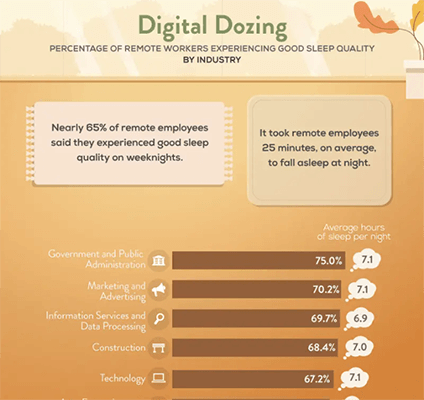
The CDC’s sleep guidelines for adults should be 7 hours of sleep per night. However, only 35% of US adults get at least the minimum amount.
On average, remote workers take an average of 25 minutes before they fall asleep.
Flexible scheduling is the top benefit of working remotely.
People find that flexible scheduling is the main reason why people have come to like working from home. It’s the top reason cited in the US (53%), UK (50%), Canada (56%), and Australia (50%).
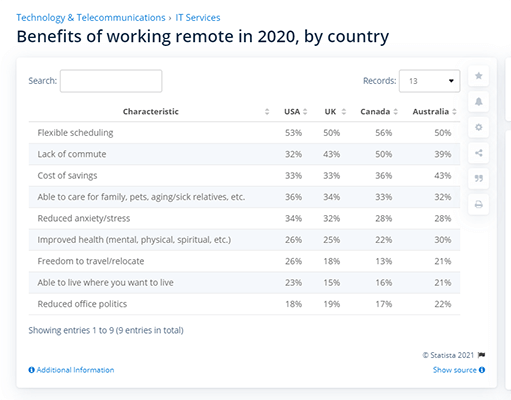
Other benefits cited are the lack of commute, savings, taking care of family/pets, reduced stress, improved health, freedom to travel, being able to live where you want to live, and reduced office politics.
Source: Statista
Remote workers earned salaries higher than $100,000 per year.
Remote workers tend to earn more than in-office workers. A study found that remote workers could earn more than $100,000 per year. That’s 2.2 times more frequently than on-site workers.
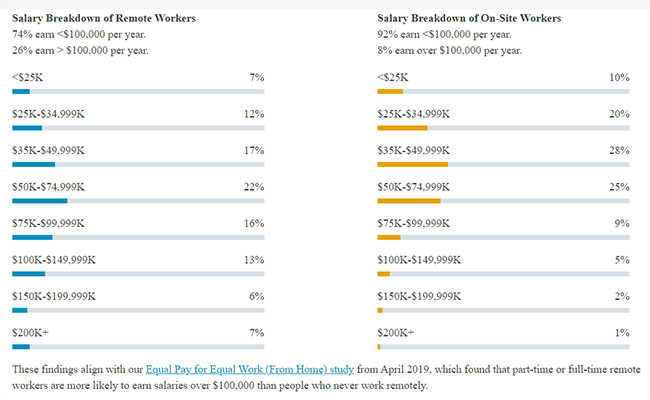
Of those surveyed, 74% of remote workers said that they earn less than $100,000 per month. However, 92% of in-office workers said the same thing. So you could argue that remote workers tend to earn more than their counterparts.
Source: Owl Labs
Most remote workers have traveled and worked at the same time.
Working from anywhere means there’s more opportunity for employees to travel. 44% of remote workers said that they travel while working between a week or a month per year.
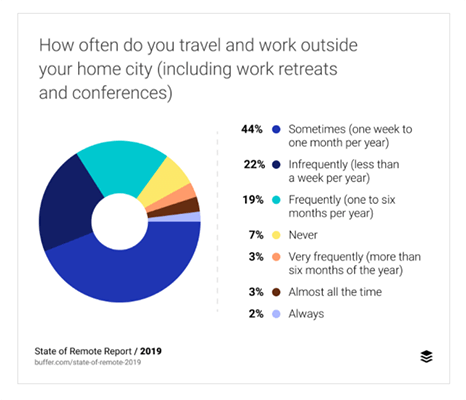
25% of respondents said they do the work-travel combination for more than one month of the year. Only 7% said that they don’t travel while they’re working.
Source: Buffer
Remote workers report stronger team dynamics and a chance for innovation.
62% of remote workers say that they feel more collaborative as opposed to 47% of those who report to the office. A good number of remote workers also feel the same way about their teams being more supportive (66% versus 47% of on-site employees).
Remote workers are also less likely to find their co-workers as gossipy (9% versus 20% of in-person workers).
Source: ADP Research Institute (via PR Newswire).
Remote work savings statistics
Working remotely has other benefits. And that’s the money you can save by not having to go to-and-from work every day. You won’t believe how much you can save on fuel alone.
And it’s not just employees. Businesses can save a lot too if they allow more employees to work at their homes.
Here now are some remote work savings statistics.
Remote workers save $4,523.04 a year on fuel.
According to a study, an employee who works from home can save $94.23 on fuel per week. That’s $476.92 per month or $4,523.04 per year. Not only that, but these employees will also enjoy more free time per week. The same study says that remote workers can save 8.5 hours per week.
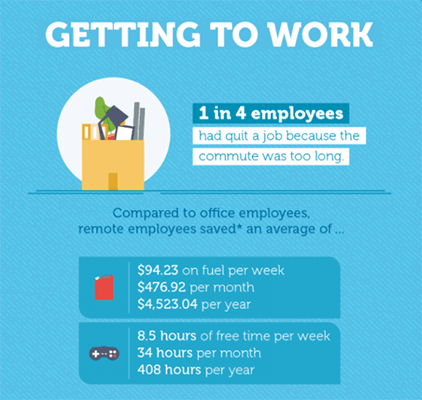
This is significant because one in four respondents said that they had to quit a job at one point because of the long commutes to work.
Source: Airtasker
Businesses can save an average of $11,000 per halftime remote worker.
Global Workplace Analytics reports that a typical employer can save an average of $11,000 per half-time remote worker per year.
The reason for these savings can be linked to increased productivity, lower real-estate costs, reduced absenteeism and turnover, and better disaster preparedness.
It’s great for employees too since they can save anywhere between $600 and $6,000 per year by working from home at least half of the time. They’ll have to pay less for travel, parking, and food. And it’ll save them time from having to commute to and from work every day.
Source: Global Workplace Analytics
Remote work statistics sources
- Gartner
- PWC
- Flexjobs
- CNBC
- Boston Consulting Group
- Forbes
- Amerisleep
- Entrepreneur (URL no longer live)
Final thoughts
Looking at all these statistics, remote work is looking like a win-win situation for both employers and employees. And because things aren’t getting back to normal anytime soon, it looks like work-from-home arrangements are here to stay for a little while longer.
But because people have not only gotten used to this arrangement but have come to love it as well, businesses should learn to accommodate. Otherwise, they’ll lose their employees to companies that are willing to shift to a hybrid remote work setup.
If you’re a business owner and you’re still on the fence about implementing a remote work policy, it’s well worth considering. It seems like the remote work trend is going to be the standard for years to come.
Looking for more business insights? Check out these stats roundups:
